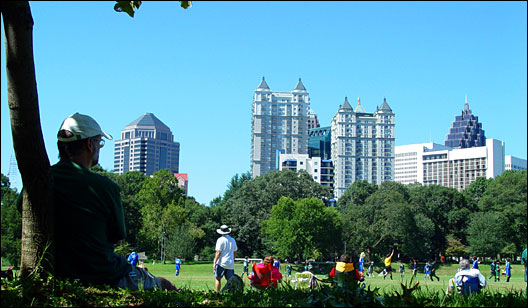I was just in Boston at the excellent Living Cities Green Boot Camp, which was focused on what it will take to actually start hugely and radically retrofitting existing buildings in cities.
Cities are, as you all know, a huge lever in solving climate change. Big cities have big climate footprints, and the bulk of those footprints are typically from buildings. The point of the boot camp was to figure out how to actually start this incredibly difficult process of fixing old buildings. How do you finance it? How do you actually do it? How do you make it happen to scale? (Doug Foy, a leading eco-luminary in the northeast who attended the conference pointed out to me the scale here: for the city of New York to meet its carbon goals, it must retrofit 50,000 buildings a year…)
I snuck out of the conference to meet briefly with Dan Bakal and Mindy Lubber of CERES. Mindy mentioned that she had joined a Boston effort to implement climate solutions. And she said something that I thought was right on point:
“Most of these initiatives end up with like 81 different suggestions…I think we should have three.” This is something I’ve been pondering for a long time–if a city or community wants to drive big change quickly, what are the top three things it can do?
Being jacked up on caffeine, I immediately suggested two to Mindy, then stalled out. My two ideas were: “Change building codes, and implement radically tiered utility rates.” These are huge levers that will drive broader change. Later in the day, I met with Ted Smith, who drove the relentless innovation at the Kendall foundation on big picture climate solutions for 15 years. Ted said “I’d add smart grid technology to that list.”
Ok-so right or wrong, we’re getting at some uber-solutions that are doable (maybe) and have all kinds of benefits. Let’s quickly look at them:
Green Codes: Changing codes, or more broadly fixing buildings, is the big hit that can, as Ed Mazria has argued, solve climate change almost single handedly because as buildings turn over and get rebuilt at about 2% annually, eventually you get them all. (www.mazria.com) Boston recently mandated that all new building projects over 50,000 square feet must be LEED-certified. But that’s not enough, because as I’ve amply proven, LEED certification doesn’t mean energy efficiency, and we need to hit all buildings, not just some.
Tiered Utility Rates: Tiered, or inclining block rates, which I’ve talked about in this blog, not only create the incentive to reduce energy use and install renewables because the return gets much more attractive. Tiered rates–which mean you pay more for electricity as you use more–could also conceivably be structured create a fund that would support low income, or even high income retrofits, from the increased revenue.
Smart Grid Technology: encourages conservation and also helps utilities manage demand, and is seen as an absolute requirement of a world that has solved climate change. I won’t go into detail about that here but many have discussed this in elaborate detail, including Tom Friedman in his new book (and in congressional testimony) and Dan Lashof at NRDC.
These are not going to be easy to pull off, of course–smart grid technology will be expensive. Tiered rates are a hard political battle. Code changes might be the easiest of the three. But if you pull these three things off, however you do it, you get an ancillary benefit that both Obama and the cities and the Living Cities bootcamp all want: more jobs. Because the smart grid will require huge amounts of labor. And the tiered rates will create funding for efficiency, and someone’s got to do this. And the new codes will create experts in efficient new construction who can extent their work now into existing buildings.
Look, I’m not an expert in these things, I’m clueless in many ways, and I’m only shooting from the hip here. I’ve certainly missed some other big ideas–like greening the power supplies of entire cities through renewable portfolio standards. I didn’t get at transportation, which is, at least in Boston or Cambridge, a lesser chunk of the problem.
But that’s why this is part 1 of 100, and that’s why I need you, the reader, to add your thoughts, please! In the end, what I’m trying to get at is a tight and short blueprint for cities to pull big levers and move quickly, and to replace the 81 point list that leaves us rocking in a corner in despair with a tangible, small list we can start working on now.




